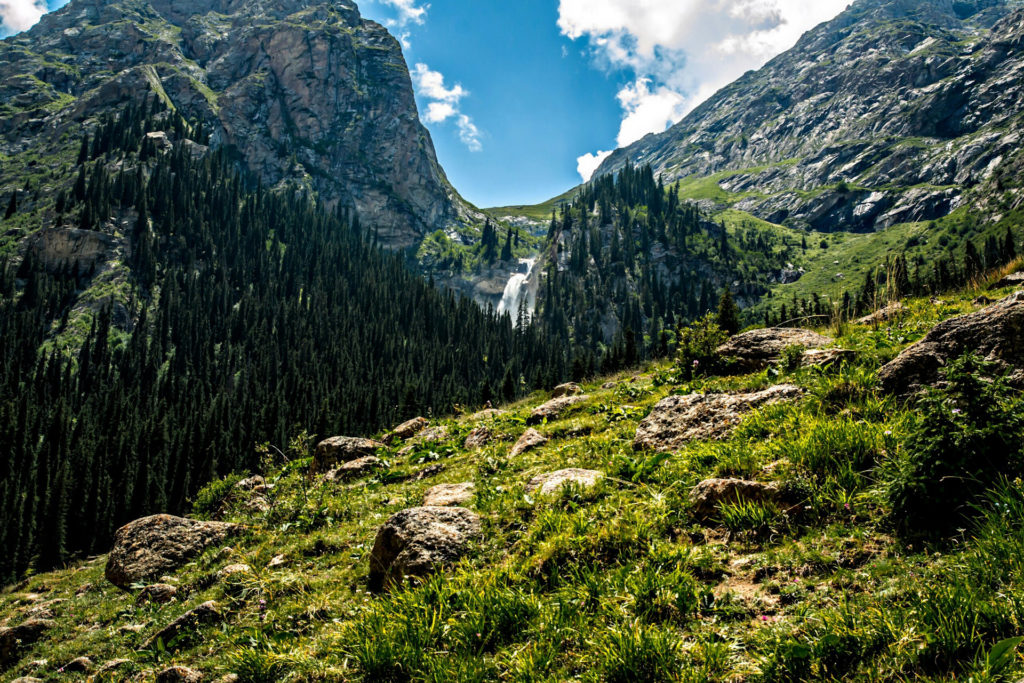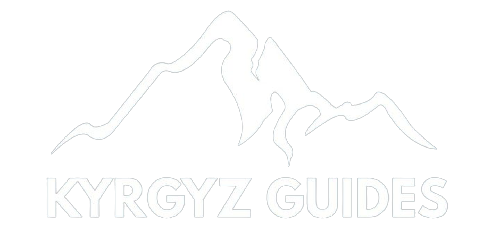Barskaun (Barskoon), a gorge. The southern coast of Issyk-Kul, 80 km from Karakol. At the entrance to the gorge is the village of Barskaun (ancient name “Barshan”). In the past, Barskhan was a Khan’s headquarters, who lived in a castle. The towns of Veliky Barskhan and Nizhny Barskhan were located nearby.
The length of the gorge is more than 30 km. Through the gorge there is a road, which connects the Issyk-Kul hollow with the overhead plains of the syrts of the Inner and Central Tien Shan through the Barskaun pass (3819 m). Through the gorge was one of the Silk Road through the pass Bedel (4284 m) in China.
At the entrance to the gorge on a brown cliff face you can see a meter-long image of a diving goat, and a little further along the road is a melted quadrangle of a rampart with corner towers. These are the remains of a once mighty fortress (IX-XIV centuries).
Now this road goes to the gold mine Kumtor and is maintained in good condition.
At the beginning of the gorge slopes are covered with a green cover of steppe vegetation, as well as rare thickets of bushes. Then begins the zone of spruce forest, which densely covers both slopes of the gorge. At an altitude of 2,800 meters, the spruce forest begins to noticeably thin. The juniper trees become more and more common and form groves in some places.
There are more than 20 serpentine mountain roads leading to the Barskaun Pass by overhanging glaciers. In the belt of the ridge from the gorge you can see a lot of sparkling snow peaks, hung with glacial drops and glaciers. Among them stand out Panfilov Heroes Peak (4610 m) and the World Peace Council (4310 m).
Along the road there are two interesting monuments – the Soviet truck, mounted on a platform and the Bust of Yuri Gagarin, in honor of the fact that he in 1962 rested on the southern coast of Issyk-Kul after his historic flight into space.
From the gorge the road goes up to Arabel syrts and Kumtor. In Soviet times the road went eastward to the upper Naryn river and formed a loop, passing through the Yshtyk pass to Ak-Shyirak, Enilchek and exiting to the city of Karakol. Now the road is impassable.
The 11th century scholar Mahumud al-Kashgari (also known as Barskhani) was a native of this area. He authored the first Turkic language dictionary, which he wrote while living in Baghdad from 1072-1074. He is also the author of Maps of the World, works on history, culture, etc.
The spectacular spectacle is represented by grandiose waterfalls located on 20 km in the picturesque forest zone not far from the road – “Manas Bowl”, “Splashes of Champagne” and “Tears of a Leopard” are the state nature monument. Another picturesque waterfall is located at 17 km.
There is a legend about the origin of the waterfall “Tears of a leopard”. A female leopard gave birth to three cubs and left them in her den to go hunting. And when she came back she saw that the unwise kittens had come out of the den and had crashed on the mountain cliffs. And she began to cry. And the tears of her boundless grief turned into a waterfall with three ledges.
Ak-Buura river
Ak-Buura, river. It flows through the territory of Nookat and Karasuu rayons, Osh oblast. It




